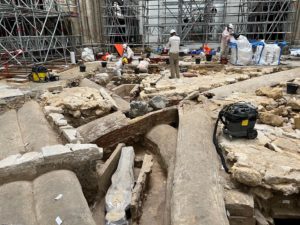In March 2022, archaeological excavations at the crossing of Notre-Dame Cathedral’s transept and nave uncovered a centuries-old lead sarcophagus. The excavations, conducted by France’s National Institute for Archaeological Research, have been in progress since February 2, 2022, and will extend for a few more weeks.
The Établissement Public, the French public agency in charge of overseeing the reconstruction, organized the excavations as a preventative measure before crews assemble the large scaffolding needed for the spire rebuilding efforts. Access to this section of the cathedral was made possible by removing the podium that previously stood in this spot, which was badly damaged during the devastating fire in April 2019.
Excavating History
The excavations discovered archaeological remains of great historical significance, offering new insight into the history of Notre-Dame Cathedral and medieval funerary practices.
Archaeologist found a fully preserved lead sarcophagus, probably that of a religious dignitary, that preliminary analysis suggests dates back to the 14th century. According to Christophe Besnier from the National Institute for Archaeological Research, the team was able to send a small camera inside the sarcophagus which showed cloth remains and organic matter such as hair and plant remnants. He said: “The fact that these plants are still there indicated that the contents have been very well preserved.”
The excavations also uncovered painted fragments of a rood screen, an ornate partition between the chancel and nave that was a common feature in late medieval architecture. The fragments found belonged to a rood screen built around 1230 and destroyed at the beginning of the 18th century. During his renovation efforts in the middle of the 19th century, architect Eugène Viollet-le-Duc found other fragments of this rood screen, which are now exhibited at the Louvre Museum.

© Michel Picaud

© Michel Picaud
